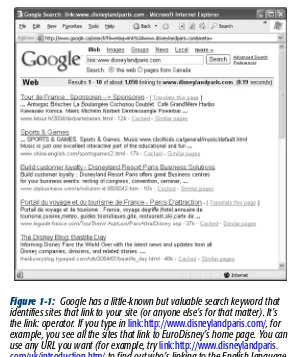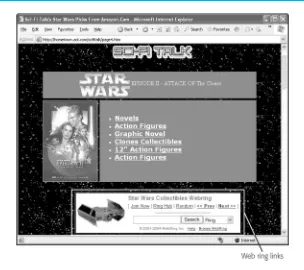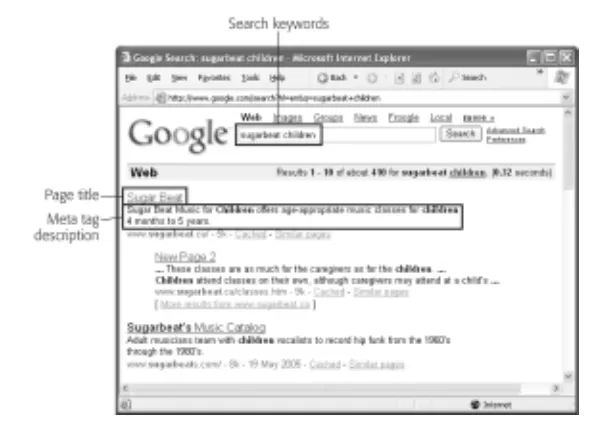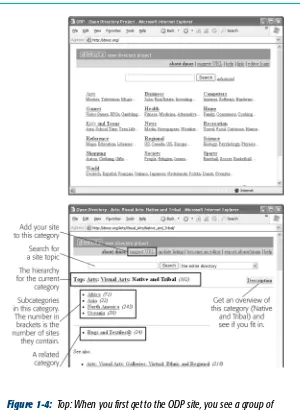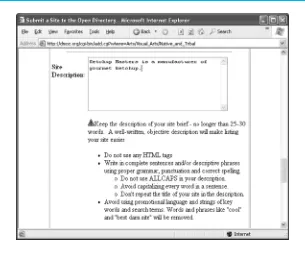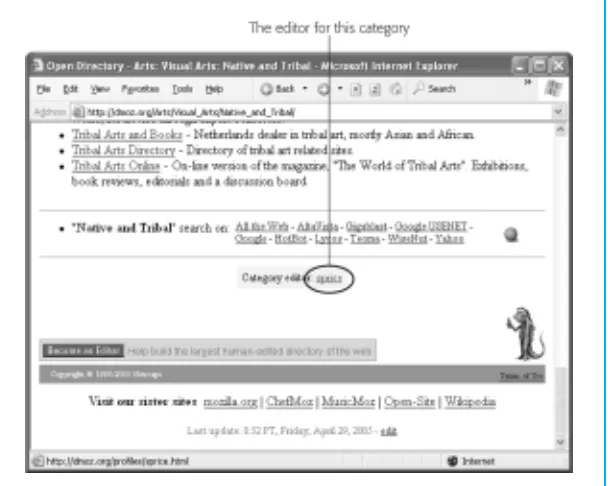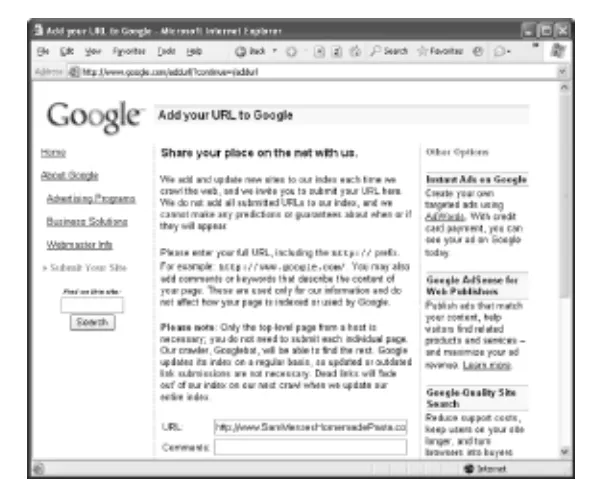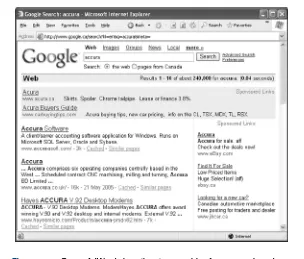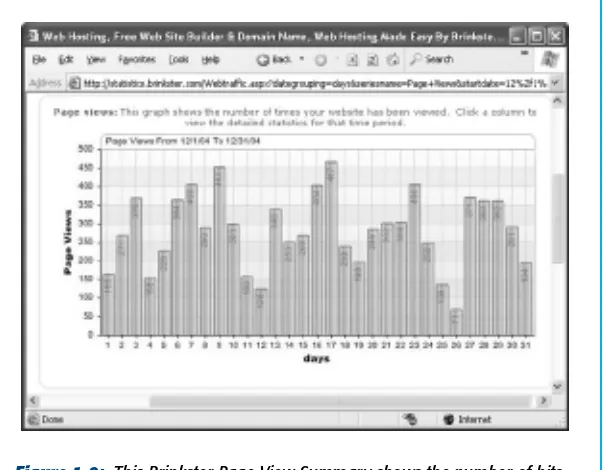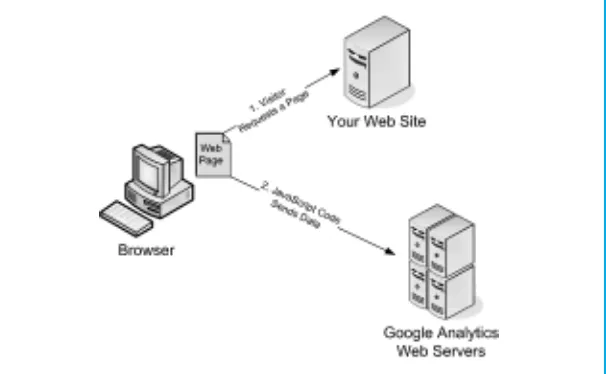Attract
Visitors to
Copyright © 2010 O’Reilly Media, Inc. All rights reserved.
Published by O’Reilly Media, Inc., 1005 Gravenstein Highway North, Sebastopol, CA 95472.
O’Reilly Media books may be purchased for educational, business, or sales promotional use. Online editions are also available for most titles: safari. oreilly.com. For more information, contact our corporate/institutional sales department: 800-998-9938 or [email protected].
January 2010: First Edition.
The Missing Manual is a registered trademark of O’Reilly Media, Inc. The Missing Manual logo, and “The book that should have been in the box” are trademarks of O’Reilly Media, Inc. Many of the designations used by manufacturers and sellers to distinguish their products are claimed as trademarks. Where those designations appear in this book, and O’Reilly Media is aware of a trademark claim, the designations are capitalized.
Table of Contents
Introduction ...v
Attract Visitors To Your Site ... 1
Your Web Site Promotion Plan ...1
Spreading the Word ...3
Reciprocal Links ...4
Web Rings ...6
Shameless Self-Promotion ...8
Return Visitors ...10
Adding Meta Elements...13
The Description Meta Element ...16
The Keyword Meta Element ...16
Directories and Search Engines ...19
Directories ...19
Search Engines...25
Tracking Visitors ...35
Understanding Google Analytics ...38
Signing Up for Google Analytics ...40
Examining your Web Traffic ...43
Introduction
A critical part of website success is attracting visitors. This Mini Missing Manual gives you the knowledge and tools you need to do that. It shows you how to build a community around your site and how to use the power of keywords and Web search engines to rise up in the rankings of search results.
Once you do that, you’ll want to see how effective your efforts are. You’ll learn how to use a powerful—and free—service that tracks visitor activity on your site; Google Analytics lets you know where your visitors live, what browser they use, which of your Web pages they love, and—just as important—which pages don’t work for them. Using this information, you can fine-tune your site to keep the visitors coming.
T
he best website in the world won’t do you much good if it’s sitting out there all by its lonesome self. For your site to flour-ish, you need to find the best way to attract visitors—and keep them flocking back for more. In this Mini Missing Manual, you’ll learn some valuable tricks for promoting your site. You’ll also see how search engines work, how to make sure they regularly in-dex your site, and how to work your way up the rankings of search results. Lastly, you’ll learn to gauge the success of your site with visitor tracking, and you’ll use a powerful free service called Google Analytics to learn some of your visitors’ deepest secrets (like where they live, what browser they use, and which of your web pages they find absolutely unbearable). Before you know it, you’ll be more popular than chocolate ice cream.Your Website Promotion Plan
Before you plunge into the world of website promotion, you need a plan. So grab a pencil and plenty of paper, and get ready to jot down your ideas for global website domination (fiendish cackling optional).
Although all webmasters have their own tactics, it’s generally agreed that the best way to market a website is to follow these steps:
1. Build a truly great website.
If you start promoting your site before there’s anything to see, you’re wasting your effort (and probably burning a few bridges). Nothing says “never come back” like an empty web-site with an “under construction” message.
2. See step 1.
If in doubt, keep polishing and perfecting your site. Fancy graphics aren’t the key concern here—the most important detail is whether you have some genuinely useful content. Ask yourself—if you were browsing the Web, would you stop to take a look at this site? Make sure you’ve taken the time to add the kinds of content that keep visitors coming back.
3. Share links with friends and like-minded sites.
This step is all about building community. Contrary to what you might expect, this sort of small-scale, word-of-mouth promotion might bring more traffic to your site than high-powered search engines like Google.
4. Perfect your site’s meta elements.
Meta elements contain hidden words that convey important information about your site’s content, like a site description. Search engines use them as one way to determine what your website’s all about. For details, see below.
5. Submit your website to Internet directories.
6. Submit your website to Internet search engines.
Now you’re ready for the big time. Once you submit your web-site to web heavyweights like Google and Yahoo, it officially enters the public eye. However, it takes time to climb up the rankings and get spotted.
7. Figure out what happened.
To assess the successes and failures of your strategy, you need to measure some vital statistics—how many people visit your site, how long they’re staying, and how many visitors come back for more. To take stock, you need to crack open tools like hit counters and server logs.
Throughout this book, you’ll tackle these steps, get some new ideas, and build up a collection of promotion strategies.
Spreading the Word
Some of the most effective promotion you can do doesn’t involve any high-tech XHTML wonkery, but instead amounts to variations on the theme of good old-fashioned advertising.
The first step is to find other websites like yours. If you create a topic-oriented site—your musings on, say, golf, fine jewelry, or jeweled golf clubs—similar sites make up your virtual neighbor-hood. They’re part of a larger online community to which you now belong. So why not introduce yourself? Strike up a reciprocal link relationship (see the next section).
Reciprocal Links
A reciprocal link is a link-trading agreement. The concept is simple. You find a website with similar content and strike a bargain: Link to my site, and I’ll link to yours. Reciprocal links are an important thread in the underlying fabric of the Web. If you’re not sure where to start searching for potential link buddies, pay a visit to Google and use the link: operator (as explained in Figure 1-1) to see who’s linking to sites similar to yours. (You can get an even more power-ful link viewer as part of the Google Webmaster Tools, described in “Google AdWords”, below.)
Reciprocal links only work if there’s a logical connection between the two sites. For example, if you create the website http://www. ChocolateSculptures.com/, it probably makes sense to exchange links with http://www.101ChocolateRecipes.com/. But http://www. HomerSimpsonForPresident.com/ is a far stretch, no matter how much traffic it gets.
Topic isn’t the only consideration in link exchanges. You should also look for sites that feel professional. If a similarly themed site is choked with ads, barren of content, formatted with fuchsia text on a black background, and was last updated circa 1998, keep looking.
Tip: reciprocal linking can require a little finesse. it’s best to look for sites that complement yours, but don’t necessarily compete with it. You’ll also have more luck if you approach web peers, sites of similar quality or with a similar amount of traffic to yours.
Once you enter into a link agreement—even if it’s just an informal exchange of emails—remember to keep your end of the deal. Don’t remove the link from your site without letting the other webmaster know about the change. It’s also a good idea to keep checking on the other site to make sure your link remains promi-nent. If it disappears, don’t fly into an Othellian rage—just send a polite email asking where it went or why it disappeared.
Reciprocal links are also a good way to start working your way up search engine rankings (see “Rising up in the rankings” below). That’s because one of the criteria Google takes into account when it determines how to order the results of a web search is how many other sites link to yours. The more popular you are, the more likely you’ll climb up the list.
Note: There are some companies that sell reciprocal link services. The basic idea is that they try to pair up different websites (for a fee) in a link-sharing agreement. Don’t fall for it. Your traffic might increase, but the visitors you get won’t really be interested in the content of your site, and they won’t hang around for long.
Web Rings
A web ring is similar to a reciprocal link, but instead of sharing a link between two partners, it binds a group of websites together.
Figure 1-2: Many Web ring sites don’t list the formal address of all the member sites. Instead, visitors move from one site to the next using previ-ous and next links. This sequence of sites makes up the “ring.”
Note: The biggest disadvantage to Web rings is that they usually require you to add a fairly ugly set of links to your page. Before you sign up, carefully evaluate whether the extra traffic is worth it, and travel to all the other sites in the ring to see if they’re of similar quality. if you’re in a ring with low-quality sites, it can hurt your reputation.
Shameless Self-Promotion
To get your website listed on many of the Web’s most popular sites, you need to fork over some cold, hard cash. However, some of the best advertising doesn’t cost anything. The trick is to look for sites where you can promote and contribute at the same time.
For example, if you create the website http://www.HotComput-erTricks.com/, why not answer a few questions on a computing newsgroup or discussion board? It’s considered tactless to openly promote your site, but there’s nothing wrong with dispensing some handy advice and following it up with a signature that in-cludes your URL.
Here’s an example of how you can answer a poster’s question and put in a good word for yourself at the same time:
Jim,
The problem is that most hard drives will fail when submerged in water. Hence, your fishing computer idea won’t work.
Sasha Mednick
http://www.HotComputerTricks.com/
com-If you’re very careful, you might even get away with something that’s a little more explicit:
Jim,
The problem is that most hard drives will fail when submerged in water. Hence, your fishing computer idea won’t work. However, you might want to check out my homemade hard-drive vacuum enclosure (http://www.HotComputerTricks.com/), which I developed to solve the same problem.
Sasha Mednick
http://www.HotComputerTricks.com/
Warning: This maneuver requires a very light touch. The rule of thumb is that your message should be well-intentioned. only direct someone to your site if there really is something specific there that addresses the question.
Some sites let you post tips, reviews, or articles. If that’s the case, you can use a variation of the technique above. Remember, dis-pense useful advice, and then follow it up with a byline at the end of your message. For example, if you submit a free article that describes how to create your groundbreaking vacuum enclosure, end it with this:
Sasha Mednick is a computer genius who runs the first-rate computing website (http://www.HotComputerTricks.com/).
Tip: if you’re a business trying to promote a product, you’ll get further if you recruit other people to help you spread the word. one excellent idea is to look for influential bloggers. For ex-ample, if you’re trying to sell a new type of fluffy toddler towel pajamas, hunt down popular people with blogs about parenting. Then, offer them some free pajamas if they’ll offer their thoughts in a blog review. This sort of word-of-mouth promotion can be dramatically more successful in the wide-reaching communities of the Web than it is in the ordinary offline world.
Return Visitors
Attracting fresh faces is a critical part of website promotion, but novice webmasters often forget something equally important— return visitors. For a website to become truly popular, it needs to attract visitors who return again and again. Many a website creator would do better to spend less time trying to attract new visitors and more time trying to keep the current flock.
If you’re a marketer, you know that a customer who comes back to the same store three or four times is a lot more likely to make a purchase than someone who’s there on a first visit. These regulars are also more likely to get excited and recruit their friends to come and take a look. This infectious enthusiasm can lead more and more people to your website’s virtual doorstep. The phenomenon is so common it has a name: the traffic virus.
So how does your website become a favorite stopping point for Web travelers? The old Internet adage says it all—content is king. Your site needs to be chock full of fascinating must-read informa-tion. Just as important, this information needs to change regularly and noticeably. If you update information once a month, your website barely has a pulse. But if you update it two or more times a week, you’re ready to flourish.
Never underestimate the importance of regular updates. It takes weeks and months of up-to-date information to create a return vis-itor. However, one dry spell—say, three months without changing anything more than the color of your buttons—doesn’t just stop attracting newcomers, it can kill off your current roster of return visitors. That’s because savvy visitors immediately realize when a website’s gone stale. They have much the same sensation you feel when you pull out a once-attractive pastry from the fridge and find it’s as hard as igneous rock. You know what happens next—it’s time to toss the pastry away, clear out the website bookmarks, and move on.
Tip: signs of a stale site include old-fashioned formatting, broken links, and references to old events (like a spice Girls cD release party or a technical analysis of why Florida condos are an ironclad investment).
GEM IN THE ROUGH
Favorite Icons
one of your first challenges in promoting your site is getting visitors to add your site to their browser bookmarks. However, that’s not enough to guarantee a return visit. Your website also needs to be fascinating enough to beckon from the bookmark menu, tempting visitors to come back. if you’re a typical Web traveler, you regularly visit only about five percent of the sites you bookmark.
one way to make your site stand out from the crowd is to change the icon that appears in visitors’ bookmarks or favorites menu (an icon technically called a favicon). This technique is browser-specific, but it works reliably in most versions of internet Explorer, Firefox, and safari. The illustration in this box shows the favicons for Google and Amazon.
Adding Meta Elements
Meta elements give you a way to add descriptive information to your web pages, which is important because some web search en-gines rely on these elements to help visitors find your site. Figure 1-3 explains how it all works.
Figure 1-3: Ever wondered where the information you see in search list-ings comes from? The underlined link in the above example (“Sugar Beat”) is the title of the Web page the search engine found. The search engine pulled the site’s description (shown underneath the title) directly from the page’s hidden description meta element.
You put all meta elements in the <head> section of a web page. Here’s a sample meta element that assigns a description to a web page:
<!DOCTYPE html PUBLIC "-//W3C//DTD XHTML 1.0 Strict//EN" "http://www.w3.org/TR/xhtml1/DTD/xhtml1-strict.dtd"> <html xmlns="http://www.w3.org/1999/xhtml">
<head>
<meta name="description"
content="Noodletastic offers custom noodle dishes made to order." />
<title>Noodletastic</title> </head>
<body>...</body> </html>
All meta elements look more or less the same. The element name is <meta>, the name attribute indicates the type of meta element it is, and the content attribute supplies the relevant information.
Meta elements don’t show up when your page appears in a browser. They’re intended for programs, like browsers and web search engines (see the box below), that read your web page from top to bottom.
Some meta elements are more important than others, because search engines heed them. In the following sections, you’ll learn about two of these: the description and keywords meta elements. These details, in conjunction with the <title> element, constitute the basic information that a search engine needs to gather about your page.
UP TO SPEED
How Web Search Engines Work
A Web search engine like Google has three pieces. The first is an auto-mated program that roams the Web, downloading everything it finds. This program (often known by more picturesque names like spider,
robot, or crawler) eventually stumbles across your website and copies its contents.
The second piece is an indexer that chews through Web pages and extracts a bunch of meaningful information, including a Web page’s title, description, and keywords. The indexer also records a great deal of more esoteric data. For example, a search engine like Google keeps track of the words that crop up the most often on a page, what other sites link to your page, and so on. The indexer inserts all this digested information into a giant catalog (technically called a database).
The Description Meta Element
The description of your page is probably the easiest meta element to come up with. You simply write a few sentences that distill the content of your site into a few plain phrases. Here’s an example:
<meta name="description" content="Sugar Beat Music for Children offers
age-appropriate music classes for children 4 months to 5 years old." />
Although you can stuff a lot of information into your description, it’s a good idea to limit it to a couple of focused sentences that to-tal no more than around 50 words. Some search engines home in on the description text, while others rely more heavily on the text in the page. Even if your description appears on a search results page, readers see only the first part of it, followed by an ellipsis (…) where it gets cut off.
Tip: The description meta element gives search engines some key information. You should include it in every page you create.
The Keyword Meta Element
Your keyword meta element should contain a list of about 25 words or phrases that represent your website. Separate each word in the list by a comma. Here’s an example:
<meta name="keywords" content="sugarbeat, sugar, beat, music, children,
musical, classes, movement, babies, infants, kids, child, creative" />
misspell-Unfortunately, there’s a huge caveat here. Most search engines don’t use the keyword list any longer. That’s because it was notori-ous for abuses (many a webmaster stuffed his keyword list full of hundreds of words, some only tangentially related to what was actually on the site). Search engines like Google take a more direct approach—they look at all the words in your web page, and pay special attention to words that appear more often, appear in head-ings, and so on. Most web experts argue that the keyword list has outlived its usefulness, and many don’t bother adding it to their pages at all.
DESIGN TIME
The Importance of Titles and Image Text
A search engine draws information from many parts of your page, not just the meta elements. To make sure your pages are search-engine-ready, you should check to make sure you use the <title> element in all your pages, and that you use alternate text with all your images.
Alternate image text is the text a browser displays if it can’t retrieve an image. You specify this text using the alt attribute in the <img> ele-ment. search engines pay attention to the alternate text—for example, Google, uses it as the basis for its image-searching tool (http://images. google.com/). if you don’t have alt text, Google has to guess what the picture is about by looking at nearby text, which is less reliable.
FREQUENTLY ASKED QUESTION
Keyword Tricks
Can I make my website more popular by adding hidden keywords?
There are quite a few unwholesome tricks that crafty Web weavers use to game the search engine system (or at least try). For example, they might add a huge number of keywords, but hide the text so it isn’t visible on the page (white text on a white background is one oddball option, but there are other style-sheet tricks). Another technique is to create pages that aren’t really a part of your website, but that you store on your server. You can fill these pages with repeating keyword text. To implement this trick, you use a little Javascript code to make sure real people who accidentally arrive at the page are directed to the entry point of your website, while search engines get to feast on the keywords.
As seductive as some of these tricks may seem to lonely websites (and their owners), the best advice is to avoid them altogether. The first problem is that they pose a new set of headaches and technical challenges, which can waste hours of your day. But more significantly, search engines learn about these tricks almost as fast as Web develop-ers invent them. if a search engine catches you using these tricks, it may ban your site completely, relegating it to the dustbin of the Web.
if you’re still tempted, keep this in mind: Many of these tricks just don’t work. in the early days of the Web, primitive search engines gave a site more weight based on the number of times a keyword cropped up, but modern search engines like Google use much more sophisticated page-ranking systems. A huge load of keywords probably won’t move you up the search list one iota.
Directories and Search Engines
find you takes more work, and monopolizes the late-night hours of many a webmaster.
Directories
Directories are searchable site listings with a difference: humans, not programs, create them. That means that a small army of work-ers painstakingly puts together a collection of sites, neatly sorted into categories. The advantage of directories is that they’re well-organized. A couple of clicks can get you a complete list of Califor-nia regional newspapers, for example. The unquestioned disad-vantage is that directories are dramatically smaller than full-text search catalogs. That means directories aren’t very useful for those in search of a piece of elusive information that doesn’t easily fall into a category, like a list of the English language’s most commonly misspelled words. Over the years, as the Web’s ballooned in size, di-rectories have become increasingly specialized, and full-text search tools like Google and Yahoo have become the most common way that people hunt for information.
The Open Directory Project
The most important directory to submit your site to is the Open Directory Project (ODP) at http://dmoz.org/. The ODP is a huge, long-standing website directory staffed entirely by thousands of volunteer editors who review submissions in countless categories. The ODP isn’t the most popular web directory (that honor cur-rently goes to the Yahoo directory), but other search engines use it behind the scenes. In fact, Google bases its own directory service (http://directory.google.com/) on the ODP.
Before submitting to the ODP, take the time to make sure you do it right. An incorrect submission could result in your website not get-ting listed at all. You can find a complete description of the rules at
http://dmoz.org/add.html/, but here are the key requirements:
• Don’t submit your site more than once.
• Don’t submit your site to more than one category.
• Don’t submit more than one page or section of your site (un-less you have a really good reason, like the separate sections are notably different).
• Don’t submit sites that contain “illegal” content. By the OPD’s definition, this is more accurately described as unsavory content, like pornography, libelous content, or material that advocates illegal activity—you know who you are.
• When you submit your site, describe it carefully and accurately. Don’t promote it. In other words “Ketchup Masters is a manu-facturer of gourmet ketchup” is acceptable. “Ketchup Masters is the best food-oriented site on the Web—the Louisville Times says you can’t miss it!” isn’t.
• Don’t submit an incomplete site. Your “under construction” page won’t get listed.
The next step is to spend some time at the http://dmoz.org/ site, until you find the single best category for your site (see Figure 1-4).
Once you do, click the “suggest URL” link at the top of the page and fill out the submission form (see Figure 1-5). The form asks for your URL, the title of your site, a brief description, and your email address.
Figure 1-4: Top: When you first get to the ODP site, you see a group of general, top-level categories.
Figure 1-5: Here’s a portion of the ODP submission form for a new site. Read all the instructions carefully, fill in the boxes, and then click the inviting Submit button at the bottom of the page (not shown here).
Figure 1-6: Click the editor’s name (“sprice”) to find out who he is, what categories he manages, and how you can email him.
The Yahoo directory
ODP is a great starting point, but it isn’t the only directory on the block. The other heavyweight is the Yahoo directory (http://dir. yahoo.com/). Unfortunately, getting your site into the Yahoo direc-tory takes considerably more work.
commercial site (one whose primary purpose is to make money) and you want to register it in the U.S. Yahoo directory, you need to pay an annual fee of several hundred dollars. And in the ultimate case of adding insult to injury, you won’t get your money back if Yahoo rejects your site.
To get started, you can review Yahoo’s official submission guide-lines at http://help.yahoo.com/l/us/yahoo/directory/suggest/ listings-03.html/. However, you’ll be much happier with the unof-ficial write-up at http://www.apromotionguide.com/yahoo.html/, which discusses your free and for-fee options, and explains what the cryptic rejection emails Yahoo sends out really mean. And if you have a commercial website, or you just don’t want to suffer through the slow and unreliable free registration process, you’ll need to use the Yahoo Directory Submit service (formerly called Yahoo Express), which is described at https://ecom.yahoo.com/dir/ submit/intro/.
Once you’re done with directories (or just ready to move on), it’s time to take a look at full-text search engines.
Search Engines
The undisputed king of Web search engines is Google (http://www. google.com/). Not only is it far and away the Web’s most popu-lar search engine, it also powers other search engines (usually without being credited). Google performs an amazing amount of work—every day it chews through hundreds of millions of search requests.
Tip: For more information about search engines, including who’s on top and who owns who, check out http://www.searchen-gineland.com/.
It’s not too difficult to get Google to notice your site. By the time your site’s about a month old, Google will probably have stumbled across it at least once, usually by following a link from another site or from the ODP. As described in the box above, Google takes outside links into consideration when sizing up a site, so the more sites that link to you, the more likely you are to turn up in some-one’s search results.
If you’re impatient or you think Google’s passing you by, you can introduce yourself directly using the submission form at http:// www.google.com/addurl/ (see Figure 1-7). Most popular search en-gines include a submission form like this. Just make sure you keep track of where you’ve submitted, so you don’t inadvertently submit your site to the same search engine more than once.
Rising up in the rankings
Home-Figure 1-7: You can safely skip the comments section on this page but make sure to include the http:// prefix at the start of your Web page’s URL.
So how do you create a site that the casual searcher’s likely to find? There’s no easy answer. Just remember that the secret to getting a good search ranking is having a good PageRank, and getting a good PageRank is all about connections. To stand out, your web-site needs to share links with other leading web-sites in your category.
Tip: it’s possible to get too obsessed with search engine rank-ings. Here’s a good rule of thumb—don’t spend more time trying to improve your search engine ranking than you do improving your website. in the long term, the only way to gain real popu-larity is to become one of the best sites on the block.
UP TO SPEED
How Google’s PageRank Works
Google uses a rating system called PageRank to size up different Web pages. Google doesn’t use Pagerank to find search results; instead, it uses it to order them. When you execute a search with Google, it pulls out all the sites that match your search keywords. Then it orders the results according to the Pagerank of each page.
The basic idea behind the Pagerank system is that the value of your website is determined by the community of other websites that link to it. There are a few golden rules:
• The more sites that link to you, the better.
• A link from a more popular site (a site with a high Pagerank) is more valuable than a link from a less popular site.
• The more links a site has, the less each link is worth. in other words, if someone links to your site and just a handful of other sites, that link is valuable. if someone links to your site and hun-dreds of other sites, the link’s value is diluted.
Although Google regularly fine-tunes its secret Pagerank recipe, Web experts spend hours trying to deconstruct it. For some fascinating read-ing, you can learn more about how Pagerank works (loosely) at http:// www.akamarketing.com/google-ranking-tips.html/ and http://www. markhorrell.com/seo/pagerank.html/. Google co-founders sergey Brin and Larry Page describe the original formulation of Pagerank in an academic paper by at http://infolab.stanford.edu/~backrub/google. html/.
The Google Webmaster Tools
If you’re feeling a bit in the dark about how your website rates with Google, you’ll be happy to know that Google has a service that can help you out. It’s called the Google Webmaster Tools, and you can sign up your site for free at http://www.google.com/webmasters/ tools/.
Note: Before you can actually use the Google Webmaster Tools, you need to prove you own the site. To do this, Google asks you to upload a small file (a task that only a site owner can per-form). once Google finishes verifying your site, you can remove this file.
The Google Webmaster Tools let you look at your website through the eyes of Google. It divides its features into several sections. When you sign up, here’s what you see:
• Overview. This section tells you whether Google has visited your site, and whether it’s successfully added your site to its index. You’ll also find links to Help documents that explain how Google sizes up a website and how you can climb the rankings.
• Diagnostics. This section warns you about any problems Google has encountered, like incorrect metadata (“Adding Meta Elements”) or pages that it couldn’t access (and therefore couldn’t index).
• Links. This section is most notable for its external link viewer, which shows you what websites link to yours. It’s like a super-powered version of the link: search operator that you learned about in “Web Rings” above.
• Sitemaps. This section helps you build a sitemap—a special file that describes the structure of your site and the files in it. You can submit your sitemap to Google and other search en-gines so they know what to index. This is particularly useful if you have pages that Google might ordinarily miss, like stand-alone pages (those not linked to other pages).
• Tools. This section lets you tweak a few miscellaneous Google settings (for example, how often it examines your site for new content). It also lets you create and analyze robots.txt files, which you can use to hide a portion of your site from nosy search engines, as explained in “Hiding from search engines”.
Most serious web designers eventually check out their websites with the Google Webmaster Tools. If nothing else, you can use it to make sure everything is running smoothly—in other words, that Google can access your site, that its automated search robots return frequently to check for new content, and that the robots review all the pages you have to offer.
Google AdWords
The idea behind AdWords is that you create text ads that Google shows alongside its regular search results (see Figure 1-8). The neat part is that Google doesn’t show the ads indiscriminately. Instead, you choose the search keywords you want your ad associated with.
Figure 1-8: To see AdWords in action, try searching for a name brand like Microsoft. You’ll see a section clearly marked Sponsored Links on the right side of the search results, or just above the search results in a yellow shaded box.
to pay. And Google doesn’t charge you anything to simply display your ad on a search results page. It charges you only when some-one clicks on your ad to get to your site.
By this point, you might be getting a little nervous. Given the fact that Google handles hundreds of millions of searches a day, isn’t it possible for a measly one-cent bid to quickly put you and your site into bankruptcy? Fortunately, Google’s got the solution for this, too. You just tell Google how much you’re willing to pay per day. Once you hit your limit, Google stops showing your ad.
Interestingly, the bid amount isn’t the only factor that determines how often your ad appears. Popularity is also important. If Google shows your ad over and over again and it never gets a click, Google realizes that your ad just isn’t working, and lets you know that with an automatic email message. It may then start showing your ad significantly less often, or stop showing it altogether, until you improve it.
Note: You can learn more about AdWords from Google: The Missing Manual, which includes a whole chapter on it, or on Google’s AdWords site (http://adwords.google.com/). For a change of pace, go to http://www.iterature.com/adwords/ for a story about an artist’s attempt to use AdWords to distribute poetry, and why it failed.
Hiding from search engines
In rare situations, you might create a page that you don’t want to turn up in a search result. The most common reason is because you’ve posted some information that you want to share with only a few friends, like the latest Amazon e-coupons. If Google indexes your site, thousands of visitors could come your way, sucking up your bandwidth for the rest of the month. Another reason may be that you’re posting something semi-private that you don’t want other people to stumble across, like a story about how you stole a dozen staplers from your boss. If you fall into the latter category, be very cautious. Keeping search engines away is the least of your problems—once a site’s on the Web, it will be discovered. And once it’s discovered, it won’t ever go away (see the box “Web Per-manence”).
But you can do at least one thing to minimize your site’s visibility or, possibly, keep it off search engines altogether. To understand how this procedure works, recall that search engines do their work in several stages. In the first stage, a robot program crawls across the Web, downloading sites. You can tell this robot to not index your site, or to ignore a portion of it, in several ways (not all search engines respect these rules, but most—including Google—do).
Alternatively, you can use nofollow to tell robots to index the cur-rent page, but not to follow any of its links:
<meta name="robots" content="nofollow" />
If you want to block larger portions of your site, you’re better off creating a specialized file called robots.txt, and placing it in the top-level folder of your site. The robot automatically checks this file first, before it goes any further. The content inside the robots.txt file sets the rules.
If you want to stop a robot from indexing any part of your site, add this to the robots.txt file:
User-Agent: * Disallow: /
The User-Agent part identifies the type of robot you’re addressing, and an asterisk represents all robots. The Disallow part indicates what part of the website is off limits; a single forward slash repre-sent the whole site.
To rope off just the Photos subfolder on your site, use this (making sure to match the capitalization of the folder name exactly):
User-Agent: * Disallow: /Photos
To stop a robot from indexing certain types of content (like im-ages), use this:
User-Agent: * Disallow: /*.gif Disallow: /*.jpeg
As this example shows, you can put as many Disallow rules as you want in the robots.txt file, one after the other.
Tip: You can learn much more about robots, including how to tell when they visit your site and how to restrict the robots com-ing from specific search engines, at http://www.robotstxt.org/.
Tracking Visitors
As a website owner, you’ll try a lot of different tactics to promote your site. Naturally, some will work while others won’t—and you need to keep the good strategies and prune those that fail. To do this successfully, you need a way to assess how your website is performing.
Almost every web hosting company (except free web hosts) gives you some way to track the number of visitors to your site (see Fig-ure 1-9). Ask your hosting company how to use these tools. Usually, you need to log on to a “control panel” or “my account” section of your web host’s site. You’ll see a variety of options there—look for an icon labeled “site counters” or “web traffic.”
UP TO SPEED
Web Permanence
You’ve probably heard a lot of talk about the ever-changing nature of the Web. Maybe you’re worried that the links you create today will lead to dead sites or missing pages tomorrow. Well, there’s actually a much different issue taking shape—copies of old sites that just won’t go away.
once you put your work on the Web, you’ve lost control of it forever. The corollary to this sobering thought is: Always make sure you aren’t posting something that’s illegal, infringes on copyright, is personally embarrassing, or could get you fired. Because once you put this mate-rial out on the Web, it may never go away.
For example, imagine you accidentally reveal your company’s trade secret for carrot-flavored chewing gum. A few weeks later, an excited customer links to your site. You realize your mistake, and pull the pages off your Web server. But have you really contained the problem?
Assuming the Google robot has visited your site recently (which is more than likely), Google now has a copy of your old website. Even worse, people can get this cached (saved) copy from Google if they know about the cache keyword. For example, if the offending page’s UrL is http://www.GumLover.com/newProduct.htm/, a savvy Googler can get the old copy of your page using the search “cache:http://www. GumLover.com/newProduct.htm/.” (Less savvy visitors might still stum-ble onto a cached page by clicking the cached link that appears after each search result in Google’s listings.) Believe it or not, this trick’s been used before to get accidentally leaked information, ranging from gossip to software license keys.
Understanding Google Analytics
In 2005, Google purchased Urchin, one of the premium web track-ing companies. They transformed it into Google Analytics and abol-ished its hefty $500/month price tag, making it free for everyone. Today, Google Analytics just might be the best way to see what’s happening on any website, whether you’re building a three-page site about dancing hamsters or a massive compendium of movie reviews.
Google Analytics is refreshingly simple. Unlike other log analysis tools, it doesn’t ask you to provide server logs or other low-level information. Instead, it tracks all the information you need on its own. It stores this information indefinitely, and lets you analyze it any time with a range of snazzy web reports.
To use Google Analytics, you need to add a small snippet of Java-Script code to every web page you want to track (usually, that’s every page on your site). Once you get the JavaScript code in place, everything works seamlessly. When a visitor heads to a page on your site, the browser sends a record of the request to Google’s army of monster web servers, which store it for later analysis. The visitor doesn’t see the Google Analytics stuff. Figure 1-10 shows you how it works.
Figure 1-10: The best part about Google Analytics is that you don’t need to keep track of any information on your own.
Using this system, Google Analytics collects two kinds of information:
• Visitor tracking. Thanks to its sophisticated tracking system, Google Analytics can determine more interesting informa-tion about a visitor’s patterns. Ordinarily, if a visitor requests two separate web pages from the same site, there’s no way to establish whether those requests came from the same person. However, Google uses a cookie (a small packet of data stored on a visitor’s computer) to uniquely identify each visitor. As a result, when visitors click links and move from page to page, Google can determine their navigation path, the amount of time they spend on each page, and whether they return later.
Google Analytics wouldn’t be nearly as useful if it were up to you to make sense of all this information. But as you’ll see, Google not only tracks these details, it provides reports that help you figure out what the data really means. You generate the reports using a handy web screen menu, and you can print them out or download the data and use it in another program, like Excel, to do further analysis.
Signing Up for Google Analytics
Signing up for Google Analytics is easy:1. Head over to http://www.google.com/analytics/ and click the Sign Up Now link.
Google Analytics is one of many services you can access with a single Google account. That means you can use the same ac-count you use for services like Gmail (Google’s Web-based mail service), Google Groups, Google AdSense, and Blogger. If you don’t have a Google account, you’ll be prompted to create one by providing your email address and password.
The URL for the website you want track (for example, http:// www.supermagicalpotatoes.co.uk/). A Google Analytics account can track as many websites as you like, but for now start with just one.
Your time zone. This lets Google Analytics synchronize its clock with yours.
3. Click Finish.
When you finish the sign-in process, Google gives you a box with the JavaScript code you need to start tracking visits (see Figure 1-11). The next section tells you how to add that code to your pages.
4. Click Finish to complete the process.
Google sends you to the main management page for Google Analytics.
5. Add the tracking code to your web pages.
When you add Google’s script code to a page, put it at the very end of the <body> section, just before the closing </body> tag. Here’s an example of where it fits in a typical web page:
<!DOCTYPE html PUBLIC "-//W3C//DTD XHTML 1.0 Strict//EN" "http://www.w3.org/TR/xhtml1/DTD/xhtml1-strict.dtd">
<!-- Put the analytics code here. --> </body>
</html>
Tip: For best results, copy the tracking code to every Web page in your site. The only exception is for frames-based sites. if you have one, don’t copy the tracking code to the pages used for navigation bars, headers, and other non-content regions. There’s generally no point in recording requests for these elements, because your site displays them automatically.
6. Upload the new version of your web pages.
Examining Your Web Traffic
As a registered Google Analytics user, you can log in to read re-ports and make sure everything’s running smoothly. If you haven’t already done so, now’s the time to head to http://www.google.com/ analytics/.
When you first log in, you see the Analytics Settings page shown in Figure 1-12. Using this page, you can add new websites you want to track or configure existing ones. You can also get a little guid-ance from a list of help topics that appears on the side.
To determine whether your website’s tracking code is working, check the Status column in the Website Profiles list. Here’s how to interpret the different status values your site might have:
• Receiving Data indicates that all’s well. Your visitors are going from page to page under the watchful eye of Google Analytics.
• Waiting For Data indicates that Google’s JavaScript code is running on your pages, but the information isn’t available for reporting yet. Usually, you see this for the first 6 to 12 hours after you register a new site.
• Tracking Data Not Installed indicates that Google isn’t col-lecting any information. This could be because you need to wait for visitors to hit your site, or it could suggest you haven’t inserted the correct JavaScript tracking code.
If you see Receiving Data, congratulations—you’re reports are ready and waiting. Click the View Reports link next to your website to continue on to the Dashboard (Figure 1-13).
The information that appears in the Dashboard can be a little overwhelming. To give you a better sense of what’s going on, the following sections break down the key points, one chart at a time.
Graph of Visits
Figure 1-13: The Dashboard displays a number of basic charts that detail your website’s vital signs. The menu on the left lets you browse to a variety of different, more specialized reports.
With a few clicks, you can change this chart to show pageviews, the count of how many web pages all your visitors viewed. For exam-ple, if an eager shopper visits your Banana Painting e-commerce store, checks out several enticing products, and completes a pur-chase, Google Analytics might record close to a dozen pageviews but only a single visit. The number of pageviews is always equal to or greater than the number of visits—after all, each visit includes at least one pageview. To see pageviews, click the down arrow next to the word “Visits” in the top-left corner of the chart, and then choose Pageviews from the list of options.
Tip: remember, you can look at the data Google Analytics col-lects over a different range of dates using the date box in the top-left corner of the Dashboard, as identified in Figure 1-13.
Site Usage
The Site Usage section (Figure 1-15) is crammed with key statistics. Details include:
• The total number of visits in the selected date range (initially, it’s the month leading up to the current day).
• The total number of pageviews.
• The average number of pages that a visitor reads before leav-ing your site.
• The average time a visitor spends on your site before browsing elsewhere.
• The percentage of new visits. For example, a rate of 75% indi-cates that 25% of your traffic is repeat business, and 75% are new visitors. Both types of visitor are important to keep your website healthy.
Note: There are some types of repeat visitors that Google won’t correctly identify. For example, if a repeat visitor uses a different computer, a different browser, or logs into their computer with a different user name, they’ll appear to be a new visitor. For these reasons, the number of repeat visitors may be slightly
underreported.
Figure 1-15: The Site Usage numbers are the most important indicator of your site’s Web health. You can click any of these stats to see a separate report with more detail.
Map Overlay
The Map Overlay section gives a fascinating look at where your visitors are located on the globe. Google Analytics divides the map into countries, and colors them different shades of green—the darker the color, the more popular your website in that country.
in a table underneath. Look for the Detail Level box at the top of the table, and then change the selection in this box from Country/ Territory to City.
FREQUENTLY ASKED QUESTION
Does Google Really Know Where I Live?
How accurate is the location data Google supplies?
Being able to determine the location of your visitors is a powerful tool. After all, if you know your Graceland Vacation site is absurdly popular in Japan, you might consider accepting payments in Yen, translating a few pages, or adding some new pictures. But Google’s geographic locating service isn’t perfect. in fact, there are two weaknesses:
• The location service is based on a visitor’s isP (internet service Provider), not the actual visitor herself. in many cases, the isP is located in a different area than the visitor’s own computer.
• isPs economize by pooling their traffic together and dumping it onto the internet at a central location. This means that even if your visitor and her Web server are in a specific city, the computer that connects these visitors to the internet might be somewhere else. As a general rule of thumb, the geographic information that Google uses is likely to be close to reality, but not exact. it’s highly likely that the country is correct, but the specific city may not match that of your actual visitor.
Traffic Sources Overview
The Traffic Sources Overview is a pie chart identifying how visitors get to your site. It has three slices:
• Referring Sites. This slice counts visitors that arrive through websites that link to yours.
• Direct Traffic. This slice counts visitors that type your URL di-rectly into a browser or use a bookmark to make a return visit.
• Search Engines. This slice counts visitors who come to your site through a search in Google or other search engine.
Figure 1-17: Over the past month, 81 percent of visitors came from referring sites, while 18 percent came directly to this site (by typing in its URL). Less than 1 percent found their way through a search engine, which suggests you might want to consider investing more time in search engine optimization (see “Rising up in the rankings” above).
The Traffic Sources Overview provides a good high-level look at what’s going on. To get more details, click the “View Report” link underneath, or use the Traffic Sources menu on the left. You can then explore tables that break down the Referring Sites and Search Engines slices. For the Referring Sites slice, you see exactly which websites send you traffic, which is a great tool for quickly identify-ing your most successful Web partnerships. For the Search Engines slice, you can review the search keywords that lead to your site, which lets you determine what your visitors are looking for (and possibly diagnose why they left unhappy).
Content Overview
Figure 1-18: In this site, BooksNET.htm is the clear winner of the Most Popular Page award, with 32 percent of the total website traffic.
However, it’s not enough to simply determine which pages your visitors view the most. Some pages are extra important because of their ability to attract visitors. For example, the page of Member Photos on your International Nudist site might attract large vol-umes of visitors who then stick around to check out your personal-ized coffee cups, clothing, and memorabilia. A good reporting tool also shows you where visitors enter your site, so you know what pages are the attention-getters that lure traffic. Almost as impor-tant are the pages that mark the end of a visit. They may indicate a problem, like a page that’s extremely large, doesn’t work correctly in some browsers, or just plain irritates people. To get this sort of detailed information in Google Analytics, click the “View Report” button in the bottom of the Content Overview section, or use the Content menu on the left side of the page.
Colophon
Peter McKie was the editor for Attract Visitors to Your Site: The Mini Missing Manual. Nellie McKesson was the production editor.
Nellie McKesson designed the interior layout, based on a series de-sign by Phil Simpson. The text font for the PDF version of this book is Myriad Pro; and the heading and note font is Adobe Formata.
For best printing results of the PDF version of this book, use the following settings in the Adobe Reader Print dialog box: A: Pages: ii–[last page number]; B: Page Scaling: Mulitple pages per sheet;
